MARKET OVERVIEW
The global Polypropylene Pipe will revolutionize piping systems for every industry. Polypropylene, a thermoplastic polymer, is expected to be promoted for great properties compared with all other competitors, because of its chemical resistance as well as high durability, easy installation. Demand for polypropylene pipes will expand in water supply and drainage and heating or cooling systems applications. The requirement for more efficient and cost-effective piping solutions by industries will make the demand for polypropylene pipes increase. Their resistance to corrosion and low installation costs are likely to fuel up the demand, as the market of emerging economies is witnessing infrastructure development on a large scale.
The Global Polypropylene Pipe Market shall be marked with rapid advancements in technology and innovations. Further, the manufacturers should look into more specific formulations of polypropylene, that are higher tensile strength, more thermally stable, and UV radiation-resistant at high intensity – therefore further making polypropylene piping more attractive for industrial applications. Also, increased communication with industry players and researchers will highlight a customized piping solution suited for the needs of varied industries. This trend will fuel the growth of the market, further continuing to serve the technical needs for a broad spectrum of applications with polypropylene pipes.
The construction and water management industries will be the principal markets for polypropylene pipes. These pipes will assume a primary role in modernizing urban infrastructure in relation to their application in ensuring that piping works is green and reliable. The emergence of a pro-environmental material will also accelerate the industry’s growth. The fact that polypropylene is an environmentally friendly material is recyclable in nature. Thus, this will act as a fueler of the increment of polypropylene pipes in the Global Polypropylene Pipe market.
Sustainability aspects and the growing need for efficient waste management will further entrench the role of polypropylene pipes in global construction projects.
The Global Polypropylene Pipe market has no limitation to the scope as it is not confined to the construction industry. The widespread adaptation of polypropylene pipes would take a long time in heavy industries like chemicals, pharmaceuticals, and food processing. These are heavy industries involving lots of applications and processes dealing with highly corrosive materials, extreme temperatures, and other complicated processes. Polypropylene holds its integrity even in such stringent conditions, which would make it impossible to replace the pipe in such applications. Industry players will further increase their adoption of polypropylene pipes to improve efficiency and minimize maintenance costs in all these sectors. This will consequently lead to increased utilization of such pipes globally.
Technological innovation, sustainable practices, and the adoption of more resilient materials will continue to mold the Global Polypropylene Pipe market. Manufacturers would be busy designing and improving the quality of polypropylene pipes to meet the demanding need for reliable, efficient piping systems. The market will continue and expand to satisfy emerging demands from new sectors because surely, global infrastructure projects would create an increasing demand in the market. The promise for future years in the Commercial piping industry looks very good, as polypropylene pipes are expected to become a standard product across the entire world in long-lasting, economically sound solutions for various applications. With more and more urbanization and industrialization, the Global Polypropylene Pipe market will play an essential role in shaping the future of worldwide infrastructure.
Global Polypropylene Pipe market is estimated to reach $5452.9 Million by 2031; growing at a CAGR of 0.7% from 2024 to 2031.
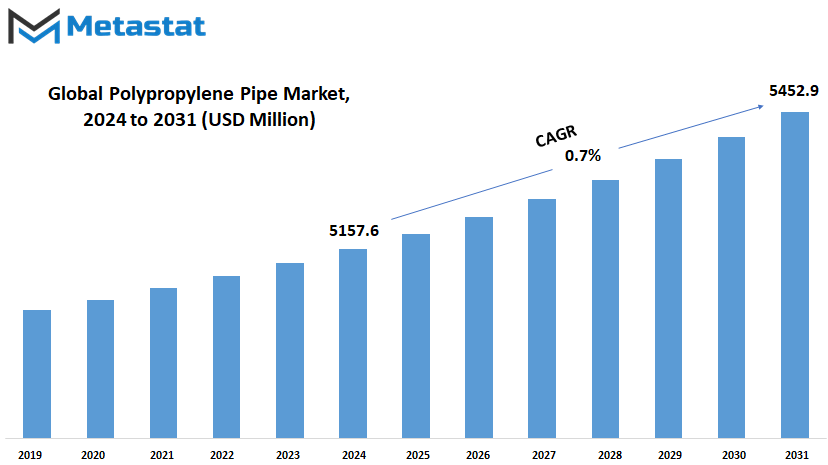
GROWTH FACTORS
The Global Polypropylene Pipe market is said to grow steadily at the pace brought about by various key drivers. Leading the pack, of course, are demand increases for tough and corrosion-resistant piping systems-the kind preferred in industrial applications and in water management systems. Polypropylene pipes would provide some significant advantages in such areas, since they can resist corrosion, making them long-lasting and reliable pipes in quite harsh environments. Given the need for effective and low-maintenance distribution of water and treatment and collection of wastewater, polypropylene pipes are increasingly shown as suitable for chemical attack, water pressure, and external wear.
Growing attention to practices that are environment-friendly is creating a new demand for polypropylene pipes that claim recyclability as one of the highest values, paralleling the trend toward 'green' construction. Another benefit is the long service life of polypropylene pipes, as these pipes are a much more durable option for projects where materials might need to be constantly replaced, thus reducing waste and the need for constant repair. This sustainable factor alone is driving widespread adoption for different green building projects. However, there are also some market challenges.
One of the largest competitive barriers is the other plastic pipes, in the form of PVC and HDPE, that may be cheaper in some applications. Often they are significantly less expensive than polypropylene up front, so are selected based on budget factors where those cost savings are critical. Polypropylene pipes are limited to lower temperature applications. Polypropylene does not have the same level of heat resistance as metal or certain other plastics, so there are limited applications with temperatures greater than 100 degrees F. This might restrict the application in the industries that require piping solutions to be capable of withstanding very high as well as very low temperatures. Still, the Global Polypropylene Pipe Market will witness great growth prospects for the next few years.
The opportunity is certainly there in the increased usage of pipes with the venture towards green building initiatives and the development of infrastructure with water conservation and resource management-based ones. As cities around the globe continue to grow and the demand for efficient water management solutions continues to increase, more applications of polypropylene pipes are bound to occur. The durability and sustainability of these pipes, combined with their cost-competitiveness, is going to make them the premier choice for new infrastructure and therefore the future of the market looks bright. The market's trajectory in the near term will remain dependent on continued innovation along with competition among polypropylene pipes and other alterative materials. Continued escalation of demand for such eco-friendly, efficient, and long-term solutions will brighten the future of the Global Polypropylene Pipe Market.
MARKET SEGMENTATION
By Type
The increasing demand for more advanced, economical, and durable piping systems is further expected to expand the global market for polypropylene pipes. Polypropylene pipes are versatile; they are highly resistant to chemicals and can survive high temperatures, thus being in widespread usage in construction, agriculture, and water management industries. This will promote growth in the market over the foreseeable future. As the world's population increases and becomes increasingly industrialized, there will be a need for better infrastructure solutions, including polypropylene pipes.
Based on type, the global market for polypropylene pipes can be divided into the three following major types of polypropylene pipes: Polypropylene-H, which is Homopolymer Polypropylene; Polypropylene-B, which is Block Copolymer Polypropylene; and Polypropylene-R, which is Random Copolymer Polypropylene. The former two have different compositions and hence different properties, suited for different application-based uses.
The most prevalent type on the market is Polypropylene-H or Homopolymer Polypropylene. It offers excellent resistance to chemicals, high temperature, and environmental stress cracking. Its use in industrial applications makes it popular for piping hot water and chemicals because it has the required durability and strength. As industries have begun to focus on sustainability as well as being cost-effective, polypropylene-H pipes will most likely be used because they are capable of working in challenging environments.
However, Polypropylene-B or Block Copolymer Polypropylene is gaining more popularity due to a better polymer mechanical property than polypropylene-H. The impact resistance capabilities of these polypropylene pipes far exceed the general properties of polypropylene-H as applied for liquid conveyance under higher pressure conditions. Considering the vast demand of good performance materials in construction and agriculture, Polypropylene-B pipes would boom in those industries since durability and strength would be inherent necessities for solid infrastructure.
Another significant part of the global market is the Polypropylene-R, or Random Copolymer Polypropylene, which has improved flexibility and a higher resistance to environmental stress cracking. It has been observed to be well applied for a range of residential and commercial purposes, particularly in water distribution systems, as urbanization across the world rises. This means that Polypropylene-R pipes are likely to become even more crucial in setting up efficient and reliable water management systems in metropolitan areas.
Increased technological breakthroughs will lead to stronger yet greener polypropylene pipes. The global market will mature because of the high demand for green products, combined with an ongoing impulse toward new construction methods. The steady growth of these three types of polypropylene pipes into the future will be supported by improved steady growth through this combination factor.
By Application
The global market for polypropylene pipes has, in the past years, shown vast growth and promises much more for future trends. Polypropylene is increasing applications across a wide range of industries because of durability, resistant, and flexible nature. This is one of the excellent platforms for the growth and development of the polypropylene pipe market evolution to meet the satisfaction for different purposes of different sectors, as people seek effective solutions that are sustainable.
Polypropylene pipes are utilized in plumbing systems. As concern for water quality increases, with the prospect of less environmental damage from the application of traditional materials at the same time, the utilization of polypropylene pipes for plumbing in the residential and commercial sectors has increased. The pipes are lightweight and easy to install, corrosion-resistant, and thus a long-term reliable solution for plumbing. It is in the area of plumbing, where sustainability and low costs will mostly increase demand for polypropylene pipes.
A second vital application area is in irrigation. The global demand for food is increasing with the need for sustainable and efficient ways of irrigating the crops. The use of polypropylene pipes to deliver water to such crops is very viable due to their resistance to chemicals and UV radiation. As agricultural practices become more modern in their operation, the irrigation sector will have a larger share of the global market in polypropylene pipes in future, thus driving high demand in support of more water-efficient farming.
Industrial process systems also provide an enormous scope for polypropylene pipes. Such pipes can withstand the most corrosive chemicals and extreme temperatures, thus suitable for chemical, pharmaceutical, or manufacturing industries. As industries expand and seek ways to make processes more efficient, the use of polypropylene pipes in industrial applications will remain firm and increasing. They are resistant to chemical degradation and shall provide preference for industries dealing with aggressive chemicals.
The primary demand driver for the polypropylene pipes market will be the water supply systems market, especially with urbanization. Cities around the world are growing, and they badly need good-quality reliable systems as well as long-lasting water supply infrastructures. Resisting high pressure and ensuring good quality of water, polypropylene pipes will in the near future shape and mold the urban water supply systems.
Polypropylene pipes have major other applications in sewage and drainage systems also, owing to their resistance towards bacterial growth and corrosion properties, it is ideal for safe handling of waste and wastewater. Therefore, the requirement for greater global population means better management of waste; consequently, the demand for polypropylene pipes for sewage and drainage systems will also rise in the coming years.
In addition, the HVAC systems market will tend towards polypropylene pipes. The most essential property of polypropylene pipe is that it provides excellent thermal insulation. Besides, it does not provide a favorable environment for the growth of mould and bacteria, which is usually a problem in HVAC applications. As energy efficiency and quality air are becoming increasing concerns, polypropylene pipes in HVAC systems would also acquire more market share.
The chemical handling sector is still going to rely highly on polypropylene pipes mainly because they show resistance to this wide range of chemicals. As capacities for hazardous chemical handling increase, such pipes will be necessary in transport and chemical handling without causing damage to the pipe or leakage during or after transportation. Polypropylene’s strength in trying conditions will make it the most preferred material for use in chemical handling systems.
The global polypropylene pipe market will always continue growing because it will keep up with the ever-increasing demand for reliable, cost-effective, and sustainable solutions for several industries. Whether it’s plumbing or irrigation, industrial processes, water supply and sewage, or HVAC systems and chemical handling, polypropylene pipes are scheduled to forge a huge lead in satisfying the needs of a fast-changing world.
|
Report Coverage |
Details |
|
Forecast Period |
2024-2031 |
|
Market Size in 2024 |
$5157.6 Million |
|
Market Size by 2031 |
$5452.9 Million |
|
Growth Rate from 2024 to 2031 |
0.7% |
|
Base Year |
2022 |
|
Regions Covered |
North America, Europe, Asia-Pacific Green, South America, Middle East & Africa |
REGIONAL ANALYSIS
The geographical spread for Polypropylene Pipe market across the globe is spread across various regions that possess different prospects and challenges. Such geographic areas will continue to evolve as the market grows, thus affecting demand and supply dynamics for polypropylene pipes. North America comprises the U.S., Canada, and Mexico and is expected to be one of the strong players in the market. The demand for polypropylene pipes can be seen mainly in industries such as construction, water treatment, and agriculture, for which they have gained preference among industries to be strong and corrosion-resistant. Moreover, pipeline innovations and environmental conditions will lead to further growth of polypropylene pipes in this region.
Europe consists of the UK, Germany, France, Italy, and so on. The markets of every industry are very competitive in this region. This makes the region lead in embracing the advanced materials, including polypropylene. The region has been a hub for sustainability and energy efficiency. Governments throughout Europe are investing heavily in upgrading their infrastructures, using polypropylene pipes as a number one choice due to their durability and cost-effectiveness. Going ahead, the existing trends in green construction practices and the need for more energy-efficient systems of water management will enhance the growth potential of the polypropylene pipe market in European countries.
The Asia-Pacific region is a big and high-growth market for polypropylene pipes mainly due to participation by major economies like India, China, Japan, and South Korea. This region is going to have massive development in the years to come, as demand for infrastructure, urbanization, and industrialization is growing. The explosive population increase in countries like India and China is putting huge demand for better water supply and sewage so the demand for polypropylene pipes has to be taken forward. Moreover, with increased concern to the environment and sustainability in this area, use of polypropylene pipes may likely be increased because they appear to be environmentally friendly.
Brazil and Argentina are among some major South American nations that lead the international market for polypropylene pipes. As the construction and agriculture sectors of both countries continue to grow steadily, a more trustworthy piping solution is needed for these sectors. Water distribution systems in South American countries are also being improved time after time, thus propelling demand within the region for polypropylene pipes.
Last but not least, interest in the Middle East and Africa, especially in the GCC countries, Egypt, and South Africa is rapidly rising. Demand herein remains primarily driven by the requirements for piping system with resistance to harsh weather and water/sewage management requirements. Infrastructure development, urbanization, and climate policies will all come to shape the future growth of the Middle East and Africa and all of them will boost the demand for polypropylene pipes.
The Global Market of Polypropylene Pipe will, therefore, continue to spread among these regions, offering different opportunities for growth and development. Its future will be determined by technological innovation, changes in regulation, and, from a global perspective, the strive for sustainability-a water mains supply for all.
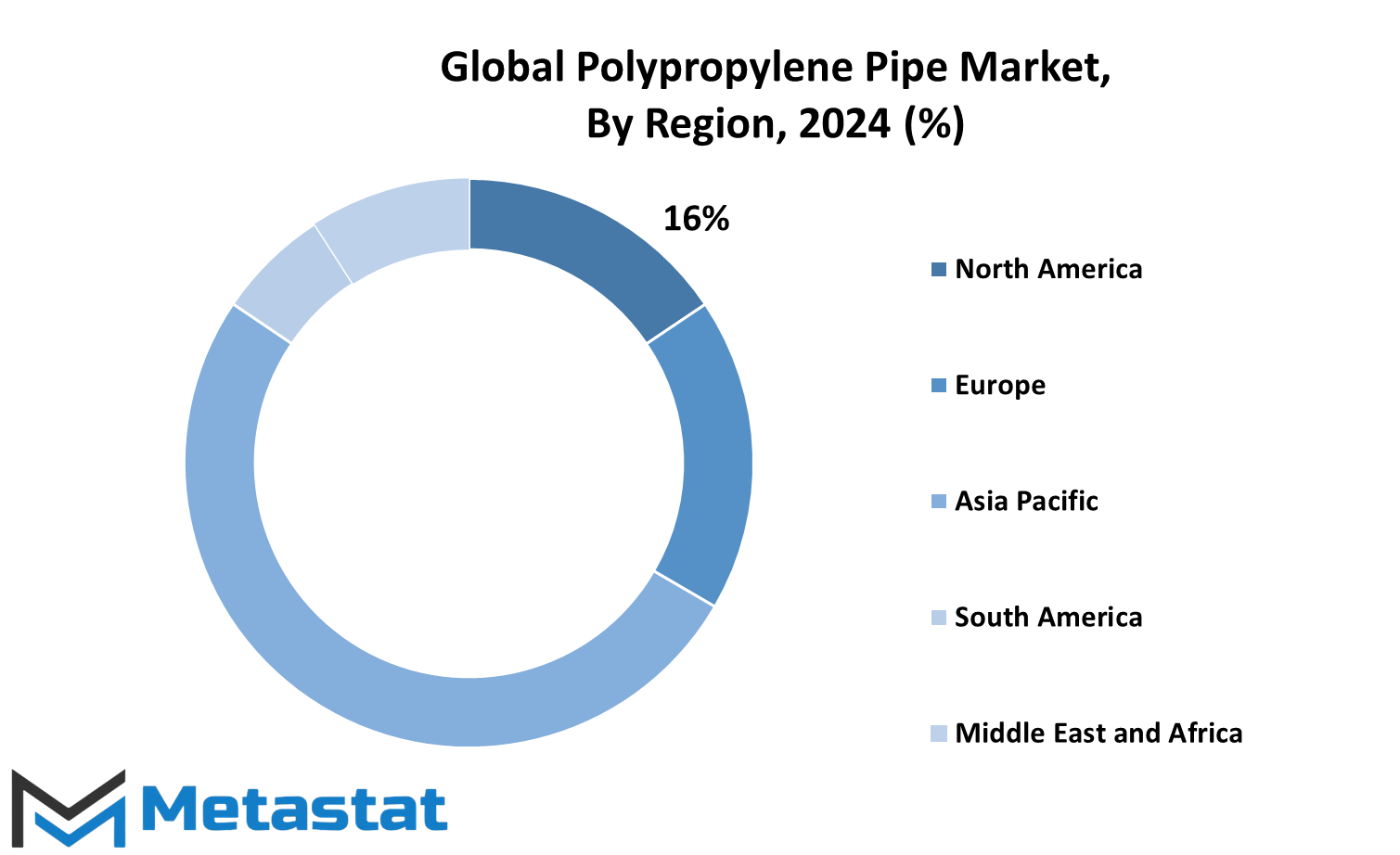
COMPETITIVE PLAYERS
This has fostered the growth of this market since polypropylene pipes are increasingly on demand in the construction, plumbing, and irrigation industries. Polypropylene pipes are likely to witness trends of betterment regarding production, use, and distribution in ways that are likely to alter the balance of pipe production and application. This will be influenced by innovative technologies and expanding industrial needs in the foreseeable future. Of these, some companies will be trying to outdo one another to corner one another with their progressive market solutions that are durable, economical, and sustainable in nature. The major firms that are quite ahead of the race include Aquatherm GmbH, Aliaxis Group S.A., and Chevron Phillips Chemical Company.
These leading companies offer the best quality polypropylene pipes to meet the most diversified applications. Their investment in research and development will also help them to succeed for a long period as new materials and new production techniques are emerging. Pipelife International GmbH and Fusion Industries Ltd lead the trends with state-of-the-art solutions that consider an upgrading of pipe performance and help reduce the impact on the environment. Products and services improvements are what companies such as Georg Fischer Piping Systems and Bänninger Kunststoff-Produkte GmbH use to sustain themselves alongside rising demand in regions from where they obtain their supplies. In future, companies such as Nupi Industrie Italiane S.p.A. and Advanced Drainage Systems, Inc. will have a chance through development of infrastructure and urbanization make polypropylene pipes very vital in any new constructions.
Prinsco, Inc. and JM Eagle, Inc. reach into new geographical markets where demand for efficient piping solutions is growing. The IPEX Group of Companies and Aquatechnik Group S.p.A. have deservedly earned a reputation for innovative and high-quality pipes of the sort to safely and reliably perform their function according to industry standards. However, Sekisui Chemical Co., Ltd. and Wavin N.V. are investing more in the environmentally friendly pipe choices which are recyclable and have better than before production processes. Thus, companies that produce more by environmentally friendly production will gain competitive advantage in the near future. Lastly, China Lesso Group Holdings Limited is building its market share and increasing production capacity to capture the galloping demand for polypropylene pipes all around the world.
The global polypropylene pipe market will keep growing as the leaders of this industry keep breaking new technological and production barriers. Expect even more competition and incentive for innovation in the face of cost savings, durability, and environmental responsibility.
Polypropylene Pipe Market Key Segments:
By Type
- Polypropylene-H (Homopolymer Polypropylene)
- Polypropylene-B (Block Copolymer Polypropylene)
- Polypropylene-R (Random Copolymer Polypropylene)
By Application
- Plumbing Systems
- Irrigation Systems
- Industrial Process Systems
- Water Supply Systems
- Sewage and Drainage Systems
- HVAC Systems
- Chemical Handling
- Others
By End-User Industry
- Residential
- Commercial
- Industrial
Key Global Polypropylene Pipe Industry Players
- Aquatherm GmbH
- Aliaxis Group S.A.
- Chevron Phillips Chemical Company
- Pipelife International GmbH
- Fusion Industries Ltd.
- Georg Fischer Piping Systems
- Bänninger Kunststoff-Produkte GmbH
- Nupi Industrie Italiane S.p.A.
- Advanced Drainage Systems, Inc.
- Prinsco, Inc.
- JM Eagle, Inc.
- IPEX Group of Companies
- Aquatechnik Group S.p.A.
- Sekisui Chemical Co., Ltd.
- Wavin N.V.
WHAT REPORT PROVIDES
- Full in-depth analysis of the parent Industry
- Important changes in market and its dynamics
- Segmentation details of the market
- Former, on-going, and projected market analysis in terms of volume and value
- Assessment of niche industry developments
- Market share analysis
- Key strategies of major players
- Emerging segments and regional growth potential



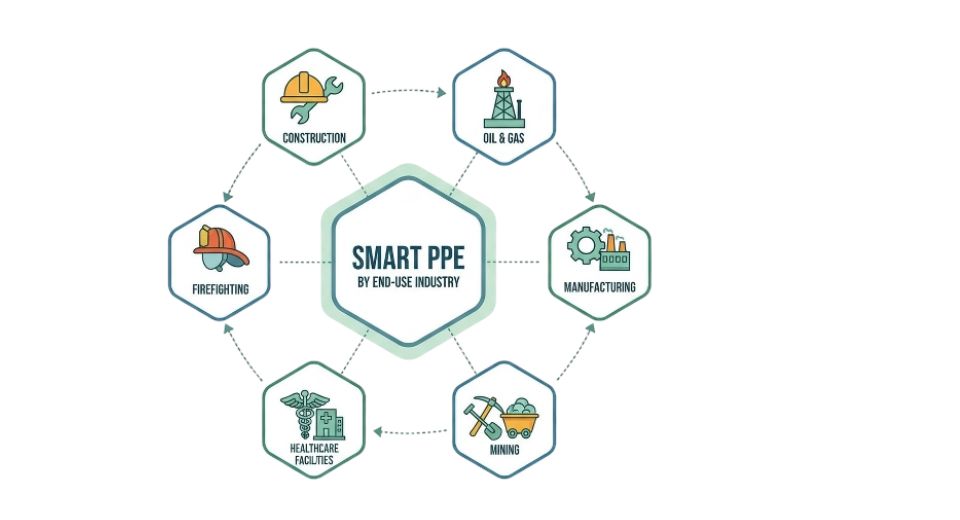
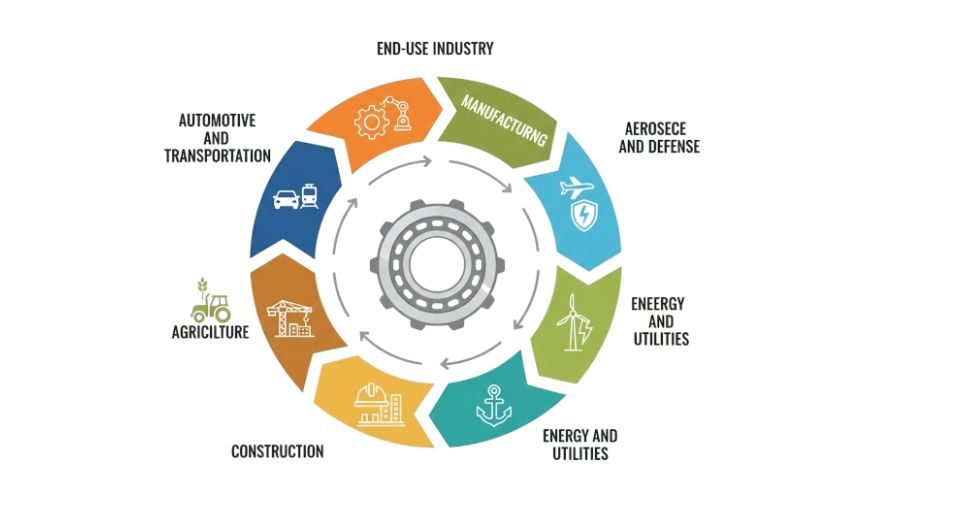
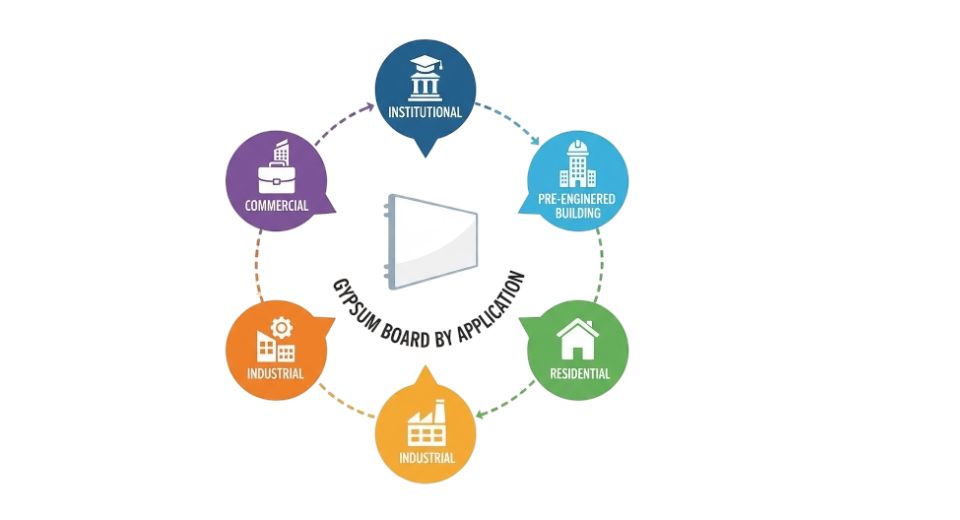
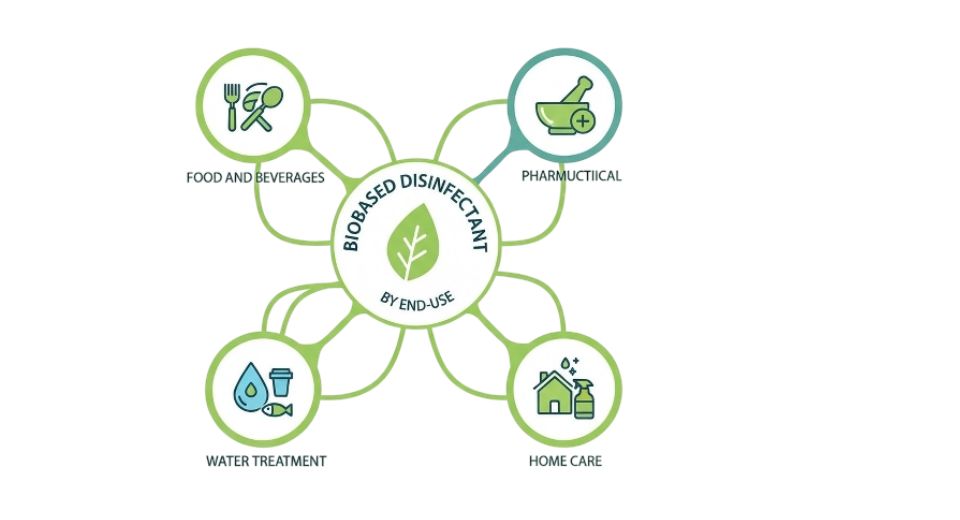

 US: +1 3023308252
US: +1 3023308252






